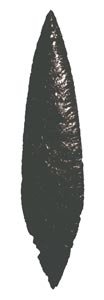History of Mesoamerica (Paleo-Indian) facts for kids
The Paleo-Indian period is the earliest time in the history of Mesoamerica when humans first lived there. It began when the very first people arrived and lasted until they started to develop agriculture and other early signs of civilization. This period ended around 9,000 years ago, leading into the next stage called the Archaic period.
Scientists still debate exactly when the first humans arrived in the Americas. However, many researchers agree that people were living in the Americas by about 11,200 years ago.
Contents
Early Human History
How People Arrived
Scientists have studied how and when the first humans came to Mesoamerica. This research is part of a bigger question: when did people first arrive in the entire western hemisphere? To figure this out, scientists look at where ancient remains and tools are found (their "context") and how old they are (using "dating methods").
At the start of the 1900s, many thought humans arrived in the western hemisphere only recently, after the last ice age. They believed people came over the Bering land bridge (a land connection between Asia and North America) around 5,000 years ago. But new discoveries changed this idea.
Important Discoveries
In the 1920s and 1930s, amazing finds at places like the Folsom and Clovis sites in North America showed that humans had been there much longer. Tools found at Folsom were about 10,000 to 11,000 years old. Tools from Clovis were even older, dating back 12,000 to 12,500 years. This meant people likely first arrived around 14,000 years ago.

The Stone Age in Mesoamerica
The time from about 9,000 years ago back to the earliest human settlements in Mesoamerica is called the "Paleoindian period." During this time, people used stone tools, which is why it's also sometimes called the "Lithic period" (lithic means stone).
Scientists have found strong evidence that humans were in Mesoamerica around 14,000 years ago. Special spear points called fluted points have been discovered in northern Mexico and central Mexico. At a site called Santa Isabel Iztapan, proof of a mammoth hunt from this period was found!
Other signs of early human presence include ancient bone tools and human skulls. These have been found at sites like Los Reyes La Paz, Xico, and Tepexpan. Scientists use different ways to figure out how old these remains are, like studying the chemicals in the bones, the layers of earth they were found in, and even volcanic ash.
Even Earlier Arrivals?
While 14,000 years ago was a big step forward, some scientists believe humans might have arrived even earlier. Evidence from places like Meadowcroft Rock Shelter in Pennsylvania and sites in Central and South America suggests humans could have been in the Americas 20,000 to 30,000 years ago.
In Mesoamerica, a bone tool from Tequixquiac might be from a very early time before spear points were common. At a site called Tlapacoya, evidence suggests humans were there about 23,000 years ago. And at Valsequillo, five sites seem to be at least 20,000 years old. These discoveries keep the debate alive about just how long humans have called the Americas home!

